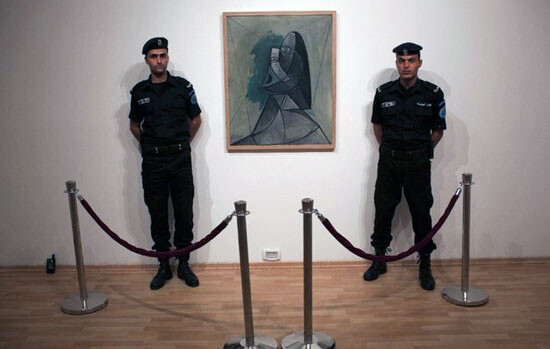→ Continued from “No Good Time for an Exhibition: Reflections on the Picasso in Palestine Project, Part I.”
The poems, at least in translation, left me unmoved, except for the beauty of the calligraphy. They were about struggle and disaster, but I couldn’t make anything of the imagery, which was all about doves and damsels and honey.
—Jean Genet1
1. The Usual Form of Events
For the official opening five days later, Khaled Hourani staged a gala event. Buste de Femme hung in its room monitored by two armed guards flanking the velvet stanchions that formed a barrier between viewer and painting. Visitors, allowed entry in pairs (to control humidity), queued outside on the veranda where they could distract themselves by examining the custom-built crate (fabricated by the German firms Hasenkamp Holdings and the Fraunhofer Institute for Material Flow and Logistics) on display in the foyer. Like any blockbuster exhibition in the West, merchandise was on sale, though Picasso in Palestine differed from the former with respect to the folkloric dancers and musicians who performed and because of the speeches given that day, one was by a head of state (if only a putative one), Prime Minister Salam Fayyad of the Palestinian Authority (PA).
What has been written about the opening so far is largely celebratory: nor did I expect to hear an impartial account from the project’s organizers. I was curious, rather, how Ramallah residents of a critical bent had received Picasso in Palestine. During our interview, Hourani appeared even to invite such criticism, stating, “For me, the discussion around the project—for or against—is part of it.”
So it was that I found myself one afternoon in July 2011, several weeks after the opening, speaking over Skype with Nicola Perugini. Perugini is an Italian anthropologist who I had met in the summer of 2010 in Battir, a village southwest of Jerusalem. He had visited the opening on the advice of his wife, Farah. “I decided to go to see more the setting than the content itself,” Perugini told me. “I mean, for me it’s becoming a preoccupation—looking at the kind of settings that are created around events. More and more I’m adopting this formalistic approach to what happens, how things are set up.”
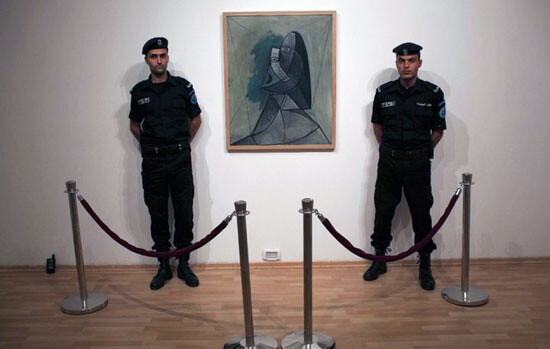

What, I asked him, was his formalist analysis of Picasso in Palestine’s opening?
This idea of creating special “gadgets” for an event, and bringing all the well-known artistic Gotta of Ramallah. Acting as if this is an open event, and then finding the area closed for security reasons. You could not park your car and you have the whole Ramallah Gotta of arts. I mean, it’s not really public. You pretend that this is a public event in which Palestinians have access to Picasso for the first time in their lives, and then you discover that it’s a caged event with some buffet from a very well-known restaurant.
One thing I was especially curious about was how Salam Fayyad was received at the opening, and, since one of Hourani’s principle talking points to the press was the notion that Palestine had yet to confront the cultural legacy of modernity, whether Fayyad also addressed this. “It was a huge celebration for Salam Fayyad,” Perugini said. “A Jordanian king-style celebration, or something that I saw only in Morocco … a celebration for the king, with people playing traditional music. Even the Palestinians were astonished. The joke circulating was: ‘Is there a wedding today?’” But according to Perugini, Fayyad himself did not address the topic of Picasso’s cultural legacy, focusing rather on the success of the PA security forces in protecting the painting:
It was simply a mirror discourse about security. The discourse of Salam Fayyad was: “We are very proud of hosting Picasso in Palestine, because we can show to the rest of the world that we have enough security to bring fucking Picasso to Ramallah.” This issue for him … [Perugini paused for a moment before continuing] he is completely drunk off this discourse that he’s reproducing everywhere about the state and “we” can grant security and “we” can assure security. Even Picasso is transformed into a security commodity. Any kind of reference to Picasso was completely erased.
Vera Tamari, a retired professor of art from Birzeit University, was more sanguine. On hand to see both Buste de Femme lifted by crane into the IAAP’s premises and for the opening three days later, she waxed ambivalent about each. Of the former she said,
It was a very moving experience for me. I had chills. It was very moving because having a piece of art by such a famous, well-known artist come to Palestine for the first time … and then it was also moving because all the people around the van—the police people, the shippers, the press people—they were oriented towards looking at it as a very important moment. The police immediately surrounded the van, and they went up on the steps like it was a combat zone. It was a bit sad, actually. I think they took it that seriously.
Her appraisal of the opening was expressed in similar terms:
It was the event more than the painting, I think, that was attracting people: “Picasso is in Ramallah, you know?” I don’t know whether the value of the painting was in their minds so much as the event itself. It was a stunt, it was a performance, it was a festivity, it was singing, it was major speeches by officials. But everybody was happy. I can understand why people would be critical, but I would take it with a sense of joviality myself. Like everything else here, you have the folklore, you have the music, you have the officials, so it became like one of the regular functions. This is how regular functions generally are managed and manifested.
When I spoke with Samar Martha, a Ramallah-based curator and Hourani’s former colleague at the Ministry of Culture, she repeated the joke about the wedding but was less critical of Fayyad than of Hourani, who had choreographed the folkloric element in the proceedings with no apparent pressure—my original presumption—from the PA:
It was Khaled’s organization, because I was totally shocked. I asked Khaled and I also asked the students, “Who decided on this?” It was Khaled who decided to do it. He asked the students and managed to convince them that this is what should be done to show Palestinian folklore. And I said, “But this kind of folklore is for weddings. Why for this occasion?” “Yeah, but it’s the wedding of Picasso,” they said.
Martha paused. I heard the click of a lighter and an exhalation of breath. “But Salam Fayyad was really smart,” she continued. “At the end of his speech, he said something interesting. He said: ‘I have nothing to do with this music and this folkloric dance. I am coming here to celebrate the wedding of Charles Esche and Khaled Hourani.’”
The conversation turned to the two days of seminars underwritten by Outset Contemporary Art Fund that followed the exhibition, the paucity of Palestinians in the audience, the fact that students from the academy were mostly absent. “It was like foreigners speaking to each other and the only heated debate was about funding,” she said. “And Khaled was a bit annoyed because, you know, it’s not acceptable in Palestine with the boycott issue to have any funding from Israel, and it was obvious this organization was very much related to Israel.”2


2. Collateral Damage
After ending our conversation, I felt a familiar confusion overtaking me. Frequently, speaking with Palestinians about life under occupation elicits the feeling that outside the crushing certitude of Israel’s ongoing territorial encroachment, there is no firm footing, no “facts” that can be reliably appealed to. One is left, rather, with a plethora of opinions, conjectures, and matters too delicate to address. Even the Oslo Agreement, the basis for negotiating the painting’s passage, holds no legitimacy in international jurisprudence outside of the peculiar afterlife it has been granted, having expired in May 1999. Was Picasso in Palestine’s stated openness to operating on many different levels—a feature I initially perceived as one of its strengths—also a weakness? Or was it a weakness inextricably intertwined with virtue, as if neither were separable within the confused context of present-day Palestine?
Picasso in Palestine operates on many different levels: on an explicitly public level concerned with the encounter between an artwork and a public, and on a more occulted level, where the slow, peristaltic bureaucratic processes of large organizations like museums and nation-states rumble along in darkness and obscurity. At least two further bifurcations mark the project’s encounter with a notional audience or public. Firstly, according to the Bourdieuian indices of cultural disposition, different sectors of the local public will have radically different experiences of the work depending on class position and education level. Secondly, there is a division between this differentiated local public and the work’s international audience, who remain—perversely—privileged “readers” of the work. A work such as Picasso in Palestine, in which a sharp division exists between these varied publics, can either make productive use of the gaps demarcating different sites of reception, or it can founder on the question of what sort of representation is disseminated and for whom.
Considering the local audience, if one central premise of Picasso in Palestine was that it made visible a lack that Palestinians experience around institutions of art and encounters with artworks (a lack that, by extension, refers to the absence of an autonomous state in which an art museum might be ideologically and topographically situated), how this lack became visible, and to whom, is crucial in evaluating the exhibition’s efficacy. Fatima AbdulKarim estimated that 4,000 people from all over the West Bank and Israel visited the exhibition. Speaking to the intelligentsia was one thing, but I was also interested in this broader, subaltern public. Without any way to gauge the response of that over-generalized aggregate called “the public,” one was thrown back on supposition; since I could not presume to speak for them, their experience remained a cipher. Picasso in Palestine, I suspected, required a sociological as much as aesthetic analysis.
Where the international audience was concerned, I stood on firmer ground, having experienced the exhibition, like them, most immediately as an image, a metonymic placeholder. Any documentation of the project could thus come to act as a représentatif, a surrogate standing in for the project as a whole. While still in the midst of my online news consumption phase, this question had preoccupied me. What material would congeal itself into a representation of the project? What would it signify, and how would this signification displace the unrepresentability of the process by which Picasso in Palestine came into being? Would it be an image of Buste de Femme ensconced in its acclimatized traveling case crossing Qalandiya checkpoint, or an image taken as the crate was hoisted by crane into the academy building? Would it be an image of the crowd at the opening listening to Salam Fayyad’s speech, or of the folkloric dance troupe that performed afterwards? Or would it be—the most widely reproduced image—the painting on display, flanked by armed guards stationed on either side of the double velvet stanchions? A project like Picasso in Palestine tests the assertion made by Jean-Luc Godard and Anne-Marie Miéville in Ici et Ailleurs that before producing one must distribute.
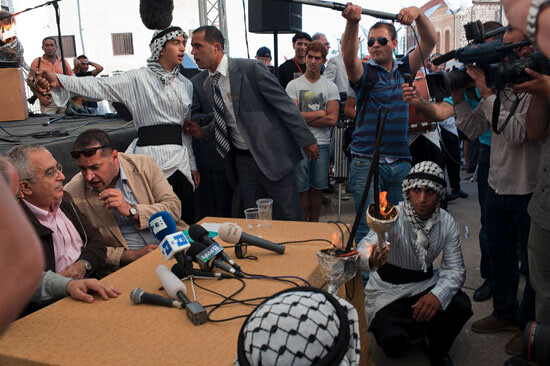

3. “In order that the portrait might appear”
Images of Picasso in Palestine are already inscribed within the legacy of photographs and photographic practices that have been spawned by the emergence of the state of Israel, which, by creating one of the world’s most intransigent political situations, has provided ample opportunity for image production. In fact, images of the conflict play a substantial role for both parties as an auxiliary force in the public relations battle to shift international opinion one way or the other. What sort of images has the conflict produced? While the Nakba itself may have been sporadically documented, this cannot be said of the refugee crisis it produced, nor of the early years of the Israeli state, where Israel was largely responsible for producing its own photographic iconography of triumphal redemption in which images of a vibrant civil society intermingled with others depicting a nation of competent, technologically adept warriors. From the beginning, then, a situation existed where it was broadly agreed that Israel possessed the competency to shape its own iconography, while the image of Palestinians was shaped mainly by UN and Red Cross documentarians. The development of a Palestinian photographic iconography has thus been marked by a passage from being subjects before the objectifying lens of an Other to authoring their own unique iconography. The media savvy of the PLO, which in its early incarnation proved more adept at propaganda than strategy, played an active role in shaping this new Palestinian image. The PLO well understood that the battle for restitution or statehood would, of necessity, be waged on the representational as well as the tactical level. Photography became a tactic in itself, where new images of Palestinians, depicted not as victims but as warriors, were produced to supersede those dating from the Nakba. Photographs of over-laden trucks, columns of woman with heaped panniers balanced atop their heads and barefoot children in tow, grandmothers traversing half-destroyed bridges and grandfathers gazing resignedly from the interiors of decrepit automobiles, while capable of eliciting sympathy, were ill-suited to the project of building a state.
As my friend R. explained in a short course on Palestinian image production he gave one afternoon in his Ramallah studio, this new crop of images produced during the period of armed resistance from 1964 to 1970 differed both in subject matter and stylization from those produced by humanitarians. Many were taken by Palestinian photographers educated in China, the Soviet Union, and elsewhere in the Communist bloc, and thus staged the anti-Zionist struggle through the lens of social realism, creating images like organizational charts, syncretistic amalgams of reference points and influences, aesthetic corollaries to the proxy wars then being waged between the Communist bloc and the West.3 These photographs issued out of two imperatives: to respond dialectically to the pathos-ridden images of the Nakba, and to safeguard Palestinians from further disappearance even as renewing armed conflict made that likelihood inevitable. Thus they filled a double gap, the first created by the destroyed villages and towns left behind in the new Israeli state, and the second by the need to create a new iconography from the image of the fedayeen, one in accordance with the ideological imperatives of armed resistance, and one that would ensure that such images were endowed with the capacity to serve as surrogates, safeguarding against a second sort of disappearance that took the form of violent death or remand into Israeli prisons. This iconographic dilemma prompted Genet to write:
The disappearance seems to be not only a vanishing but also a need to fill the gap with something different, perhaps the opposite of what is gone. As if there were a hole where the fedayee disappeared, a drawing, a photograph, any sort of portrait, seems to call him back in every sense of the term.
Genet then asks a rhetorical question that, a quarter century after Prisoner of Love was first published, deserves re-elaboration: “Did he vanish deliberately in order that the portrait might appear?”4
Where Genet identifies an ethics of martyrdom involving the voluntary decision by a fedayee to give up his life in order to become an image, Ariella Azoulay posits another type of icono-ethical relationship inhering in the photographic topos of the occupation. In her book The Civil Contract of Photography, Azoulay asserts that photography is a tool for revealing the difference between citizens protected by the sovereignty of the state and stateless persons who, deprived of recourse to law or political representation, exist in a no man’s land where catastrophe and disaster are perpetual features of the socio-economic landscape. More than an act of aesthetic appreciation, looking at (or as Azoulay puts it, “watching”) photographs is a civic skill activated by the apprehension that citizenship is not merely a status, a good, or a piece of private property, but rather implies an obligation to combat injuries perpetrated against citizen and noncitizen alike. Photographs create a semi-autonomous zone, “a space of political relations that are not mediated exclusively by the ruling power of the state and are not completely subject to the national logic that still overshadows the familiar political arena.”5 And just as Picasso in Palestine appears to follow Godard and Miéville’s assertion that one needs to distribute prior to producing, in evoking a photographic space of mediated relationality, Azoulay also seems to refer to Ici et Ailleurs, particularly a section around the twenty-fifth minute, where the ethical stake of Azoulay’s theory of a photographic civic sphere is cast within the Hegelian concept of recognition:
As a matter of fact it is likely that a chain also consists in arranging memories, chaining them in a certain order which will get everybody to find one’s place in the chain again. That is, to rediscover one’s own image. OK, but then: How does one find one’s own image in the other’s order or disorder? With the agreement or disagreement of the other? And then: How to construct one’s own image? One’s trademark, that is, an image that marks, that leaves tracks … by using the gaze of another that for convenience one calls my “likeness.” And under the gaze of a third person who is not yet there but is already represented by a photographic lens and who believes you or me, you and me when we look at this image. As a matter of fact it is likely that one constructs one’s own image with the other’s. Friend or enemy, you produce your image. You produce and consume your image with mine, distributing mine to your image.6
Invoked here is a Western subject interpolated by those unfortunate enough to have befallen the political disorder that the developed world so often propagates outside its borders, an ancillary cost to maintaining internal stability. Photography provides the proof of this process: “Taking photos, being photographed, and disseminating and looking at photos … provides a privileged access to the problem of impaired citizenship, as well as a moral practice in face of the vulnerability this condition creates.”7
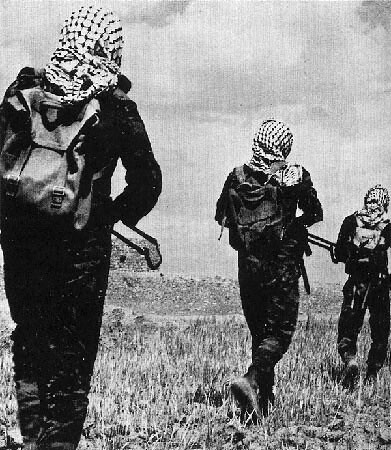

4. Parting Shots
The work is the death mask of its conception.
Azoulay, Godard, and Miéville’s appeal for us to locate our place in the image chain of late colonialism stands in contradistinction to the normative military, political, and semiotic operations by which, either tacitly or explicitly, subjugated peoples learn to accept their subjugation as an image along with the concrete situation it corresponds to. One could even asseverate that Picasso in Palestine’s most iconic, frequently disseminated image—that of Buste de Femme flanked by armed guards—banks precisely on the notion that a photograph possesses the capacity to make visible this differential relationship between citizen, noncitizen, and sovereign. That this image is capable both of staging the “impaired citizenship” of Palestinians and being a disturbing reminder of how fragile their government’s mandate actually is speaks to the iconic and discursive binaries that Picasso in Palestine navigated in its journey from Eindhoven to Ramallah. Navigating such disjunctures—between ostensibly stable democracies and occupied, fragmented societies—is part and parcel of the task of fabricating identity within a chain of images—“finding one’s own image in the other’s order or disorder.”
This semio-ethical analysis fails to address what remains the knottiest element of Picasso in Palestine—that is, the irresolvable differential between the project’s structural implications and its documentary form. Few exhibitions in recent memory have so ambitiously intervened in a real political situation, and few have fallen as short in successfully representing this process concretely, leaving commentators such as myself to fill in the gaps. These gaps also redound to the limitations of photography, where, as Bertolt Brecht noted eighty years ago, “The situation is complicated by the fact that less than ever does the mere reflection of reality reveal anything about reality. A photograph of the Krupp works or the AEG tells us next to nothing about these institutions.”8 This insight is all the more relevant considering Remco de Blaaij’s observation that much of the decision-making which ultimately allowed Picasso in Palestine to happen occurred behind closed doors, with little or no evidence—photographic or otherwise—to indicate how exactly permission for the painting’s passage was finally granted.
How, in the end, does one represent the invisibility of bureaucratic procedure, when it operates not in accordance with the transparency of the law, but alongside it, in darkness? This is an especially apposite question considering that one of the project’s central presuppositions, by virtue of a synecdochic logic, is an assertion of the political and ethical efficacy of the ideals of universal right and transparency as embodied in and transmitted through the project of fabricating an art museum and installing within it a work of high modernism. The makers of Picasso in Palestine thus resuscitate both the museal project and that of “universal” autonomous art under the signs of their identification with an ascendant bourgeois civil society—perhaps doing so as a means of complicating the question of who is granted this privileged identity and who is barred from it, or perhaps not.9
Equally clear is that, conceptually, both museum and masterwork rest on a foundational claim identified with a prior (universal) cultural norm. As Judith Butler makes clear, the détournement of such a claim by those not authorized in advance to make it requires an act of translation to avoid appearing under the signs of a colonial, expansionist logic. However, any universal claim is itself not accomplished outside of being staged within a particular context, making it impossible to separate its formal from its cultural features. Picasso in Palestine’s deployment of the artist Picasso’s iconicity thus does not evade such a move’s historical baggage but rather enters into a situation of double infection contaminated both “by the particular contexts from which it emerges and in which it travels.”10
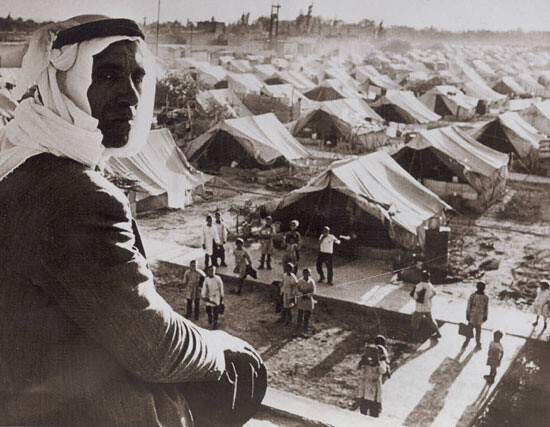

As Butler notes, the appropriation of the term “universal” by those who have been excluded from its purview commonly “produces a performative contradiction” that “is not self-cancelling, but exposes the spectral doubling of the concept itself.”11 One can cite the project’s deployment of a particular modernist artifact within its ersatz white cube as a carrier for this doubling, with its particular and universal aspects oscillating uneasily between the partiality of the local and “the ‘empty and ineradicable place’ of universality itself.”12 As claimants to the legacy of a still-contested universality, neither Picasso nor Palestine escapes the shadow of either. This “confusion point” of particular universals and universal particulars might account for the unease expressed by many with how the folkloric Palestine of the fellah, with its traditional music and dancing, was deployed at the exhibition’s opening celebration. These elements, perceived by many as inappropriate or ill-fitting to the event, in themselves express certain tensions—between residual and emergent cultures, agrarian and urban lifestyles, conservative/religious and liberal/secular ideologies—that characterize life in the contemporary West Bank. I even came to suspect Hourani’s garish staging of the opening was a deliberate effort to tweak the sensibilities of the more westernized Palestinian culturati so as to make precisely this point.


5. The Picasso Syndrome
At some point I had begun to think of Picasso in Palestine as a vector in the epidemiological sense of demarcating the route of infection of a communicable disease, its passage through the mechanisms of occupation infecting the whole bureaucratic apparatus. In this viral capacity, I thought of the project as a dispositif for disambiguating how occupation is maintained, capable of marking the system it traversed—like the type of stink bomb the IDF has used lately against protesters in the West Bank which possesses a chemical signature capable of penetrating deep into the cellular tissue and persisting for days, creating a disagreeable and incriminating stench. Now I saw that the project’s potential was polyvalent. It could also be viewed as a Picasso complex, or, to use a term favored in Ramallah, a Picasso “syndrome,” a contagion producing illusions rather than symptoms—illusions further obfuscating the bureaucratic processes that the project hoped to uncover beneath a false representation of how they function. In this sense, Picasso in Palestine is a semiotically polymorphous work: Charles Esche could consider the work a successful attempt to refunction a museum collection as a political agent; Khaled Hourani could envision the work as anticipating (or promoting) a two-state solution; critics could claim that the project opened itself to instrumentalization as publicity for the PA and its security apparatus; AbdulKarim could maintain that the project triumphed over insidious forces that attempted to thwart the exhibition; and on their website, the IDF could assume credit for waiving the normal sixteen percent duty “due to the special circumstances of this case” and for coordinating the artwork’s return to the Netherlands, adding as a parting comment that “the Civil Administration was pleased to contribute to this endeavor and will continue to assist in any and all such artistic and cultural efforts in the future.”13
It comes as no surprise, then, that the new analyses of Picasso’s sixty-nine-year-old painting are equally polyvalent. Buste de Femme can be “an ugly painting” (as AbdulKarim first thought) or, in a conversation recorded in the garden of the IAAP, Žižek could describe it as an “occupied face” whose gaze is split, with one “terrorized lively eye” cowering beneath a “horrible metallic eye like in Terminator.” The painting could be interpreted as depicting a pregnant or nursing mother with one eye on her child and another on the war, the opinion of a member of the security detail as recounted to me by AbdulKarim (repeating a story told previously to the Guardian newspaper). Even Picasso himself expressed this ambiguity. In one of the modern art galleries of the Israel Museum in Jerusalem, there is displayed a wall text next to his 1943 painting “Atelier Window” (one of nine Picassos the museum owns or possesses on permanent loan), where one can find the following quote: “I have not painted the war but I have no doubt the war is in these paintings.”
Depending on your perspective, Picasso in Palestine was a way of imagining a fully autonomous Palestine to come or a denial of its present unfreedom. All of these interpretations could be correct, and each, like the proverb of the blind men and the elephant, left other significations unread. Picasso in Palestine is, at heart, antinomic. The project, like the painting itself, had something for everyone, and its passivity towards being embraced by wildly disparate positions is perhaps what Charles Esche referred to when he spoke of the project as “ambivalent.” Some time during its passage from Eindhoven to Ramallah, it became a spectral double of itself, and this doubling was amplified by the dual scopic regimes the project, of necessity, came to inhabit: whatever else it stood for, it still stood for difference.
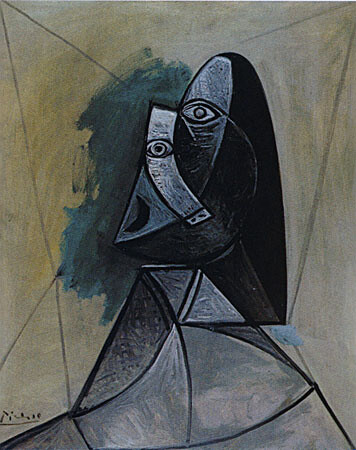

6. What Do Pictures Want?
The question that has gone unasked, perhaps because on some level it is absurd, is: What does the Buste de Femme itself want? As W. J. T. Mitchell has noted, the default position of images is feminine, constructing spectatorship out of the image as bearer of a scrutinizing male gaze. What a picture wants, Mitchell avers, is to switch places with the viewer, exchanging the passive acceptance of a look for the more active capacity to enthrall, to arrest, to capture the beholder’s attention, turning “him” into an image. “This effect is perhaps the clearest demonstration we have that the power of pictures and of women are modeled on one another and that this is a model of both pictures and women that is abject, mutilated, and castrated. The power they want is manifested as lack, not as possession.”14 Perhaps in Palestine even the most affirmative project lends itself to this sort of lack as a spectral double of its own aspirations, as if every catastrophe since the Nakba is always already inscribed there as a structural condition for becoming. The painting’s unconsidered desire could thus mirror the thwarted desire of Palestinians themselves: for a state, for restitution, for a museum to enshrine this state-to-come in a portrait, and in so doing, to resuscitate the primacy of a dominating masculine gaze. Palestine, prefigured as a woman within the tradition of resistance iconography, now appeared as a portrait without semblance, split within itself, and splitting, too, the vision of her beholders, whose gaze oscillated between the painting itself and the guards standing by with their weapons at the ready. Judith Butler writes, “To claim that the universal has not yet been articulated is to insist that the ‘not yet’ is proper to an understanding of the universal itself: That which remains ‘unrealized’ by the universal constitutes it essentially.”15 What is “called back” by the image of Buste de Femme is not Genet’s lost fedayeen but a resemblance yet to emerge.
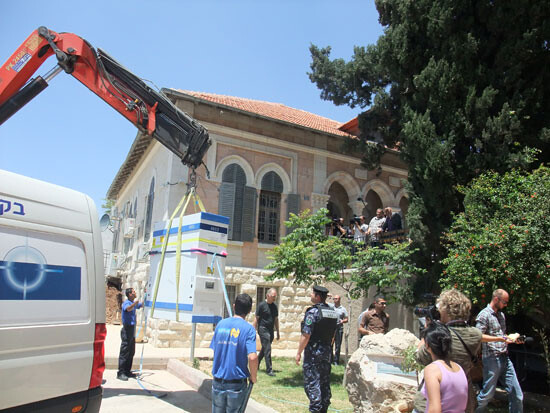

7. Coda
When I first read of Mahmoud Abbas’s plan to press a vote for statehood at the UN, for once my initial suspicion was born out by the passage of events. The crowds that gathered in West Bank cities to watch Abbas’s speech to the UN on September 23, 2011, might have perceived a hollow tone to their applause had they listened intently, for after the great fanfare and near universal enthusiasm that attended the submission of Palestine’s membership bid, a little under two months later, France joined Britain in agreeing to abstain, and the Security Council quietly announced its decision to postpone the vote indefinitely, saving the United States from the uncomfortable prospect of vetoing the measure. Wrote Chris McGeal of the Guardian, “The Portuguese ambassador, José Filipe Moraes Cabral, currently Security Council president, suggested that it was in no hurry to get to a vote. He said the council faces a ‘very busy workload’ and has yet to decide when it will meet to discuss the application.” After the UK announced its abstention, Foreign Secretary William Hague offered the absurd yet, in the context of the moment, eminently plausible explanation that while the PA “largely fulfills the criteria for UN membership,” granting it member status would impede its “ability to function effectively as a state.” The extended performance that was the UN membership application had foundered definitively on the shoals of realpolitik.
During the months I worked on this text, I came to associate Picasso in Palestine with the UN vote, not only because the latter effected the scheduling of the former, but because they so clearly expressed the same desire: recognition of Palestine as a functioning civil society rather than some mutant affront to the smooth operation of international diplomacy. I also came to feel that they might, potentially, meet the same fate, episodes in a perpetually amnesiac news cycle, nothing changed and no gains accomplished. Outside of Palestine’s admission to UNESCO (a development that immediately prompted the United States to threaten withholding its contribution to the agency’s budget), the political theatrics that had appeared so heroic in September had by November been seemingly forgotten.
When I spoke to Hourani in July, he said they were not sure what to do with the room where the Buste de Femme hung. It was still intact, its sheetrock walls ringing with a semiotic charge left over from the exhibition. Today it is used as a classroom. What it will be used for next remains an open question.
Genet, Prisoner of Love, trans. Barbara Bray (New York: New York Review Books, 2003), 19.
When I asked Fatima AbdulKarim, who joined the Picasso in Palestine project after quitting her job at the PA Ministry of Foreign Relations, about Outset Contemporary Art Fund and its relationship to Israel (Outset, set up by Yana Peel and Candida Gertler—formerly a Goldman Sachs banker and a journalist, respectively—is a London-based arts charity with branch offices in Munich, Tel Aviv, and Mumbai), her answer was interesting for its diplomatic resourcefulness and careful negotiation of the issue:
Genet writes, “To anyone looking at their pictures on television or in the papers, the Palestinians seemed to girdle the earth so fast they were everywhere at once. But they saw themselves as swallowed up by all the worlds they travelled through.” (Prisoner of Love, 24.) He articulates a truth of which he may be only partially aware.
Ibid., 23.
Ariella Azoulay, The Civil Contract of Photography, trans. Reva Mazali and Ruvik Danieli, (Brooklyn: Zone Books, 2008), 12, 14.
Jean-Luc Godard and Anne-Marie Miéville, Ici et Ailleurs (Paris: Gaumont and Sonimage, 1976.)
Azoulay, ibid., 35-36.
Quoted in Walter Benjamin, “A Small History of Photography,” inOne Way Street and Other Writings (London: Verso, 1985), 255.
While watching a discussion on YouTube among Hourani, de Blaaij, and Slavoj Žižek, my attention was arrested by the following exchange that frames the stake over asserting normalcy or non-normalcy in an interesting manner:
Judith Butler, “Restaging the Universal,” in Contingency, Hegemony, Universality, Judith Butler, Ernesto Laclau, and Slavoj Žižek (London and New York: Verso Books, 2000), 40. The particularity of the universal haunts even its origins. Susan Buck-Morss asserts in “Hegel, Haiti, and Universal History” that in conceptualizing a master/slave dialectic, Hegel’s philosophical inquiry was inspired by his long advocacy of abolition and acute interest in the Haitian slave uprising against the French, which resulted in the first and only republic in the western hemisphere to be founded by former slaves, who based their political demands precisely on Enlightenment conceptions of universal rights denied them by the French.
Ibid., 32.
Ibid., 38.
The post can be found at →.
W.J.T. Mitchell, “What Do Pictures Really Want?” October 77 (Summer 1996): 76.
Butler et al., ibid., 39.
